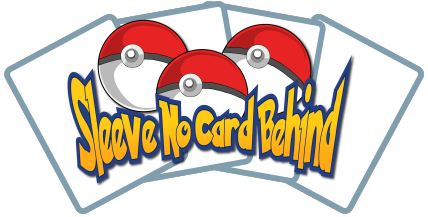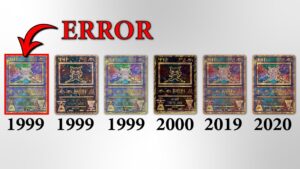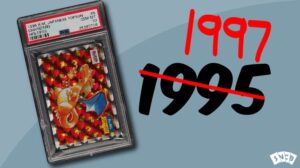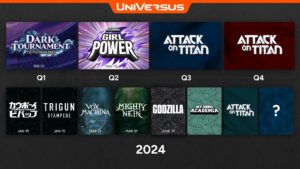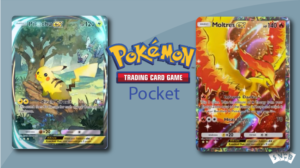Why is Pokémon Card Quality Bad?
-
By: Oliver Copeland
- Published:
- Last Updated: December 3, 2023
Recently, Pokémon card quality has been in a rut. Corners are not square, edges aren’t smooth, and everyone is pulling misprints. But why is this happening? Chilling Reign was especially bad, but we didn’t see an improvement in Evolving Skies, Fusion Strike, or even Brilliant Stars. What’s going on?
The Pokémon Company had to heavily increase the printing process of Pokémon cards to meet the demand driven by the pandemic lockdowns. This, mixed with the global supply chain shortage, created a supply and demand issue. High production resulted in low card quality.
Recent Pokémon Card Quality
Unless you’re brand new to Pokémon card collecting, then you’ve probably noticed a severe drop in quality this past year or so. Community members are reporting all kinds of radical quality control issues such as misaligned cards, blurry cards, or even cards cut in half.
Of course, pulling half a card from a booster pack is an extreme example. Most of us have, however, pulled multiple cards with poor corners or rough edges. This is especially disappointing if you pull your chase card, only to discover that it is severely off-center.
Grading companies give cards a grade based on four subcategories: Surface, Corners, Edges, and Centering. Checking these four areas of a card can quickly reveal the quality.
Surface: Hold the card below a lighting source and slowly move it, focusing on the reflection. If the card is straight from a booster pack, you’ll primarily be checking for print lines. A print line is a straight line often across the foil area of the card. Print lines have become much more common in the past year. Also check for any blemishes, ink dots, or other printing errors.
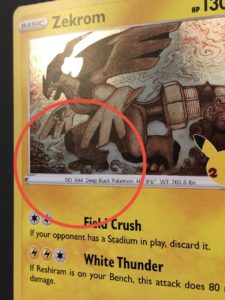
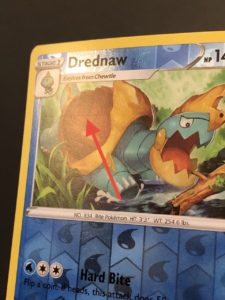
Corners: The corners of a Pokémon card should be perfectly round and symmetrical, with no raised edges. The corner should be smooth, without any jagged cuts.
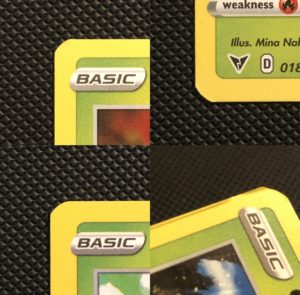
Edges: The edges of the card should be smooth, leaving no evidence of a dull blade. A dull blade will often result in a rough edge, with burrs along the cut.
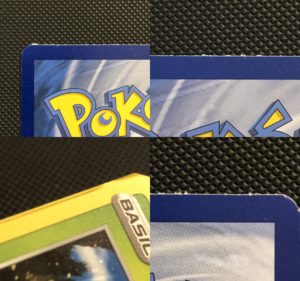
Centering: Most Pokémon cards have a yellow border, but they will sometimes have other variations such as GX cards, which have a silver border with a black line going through it. The border should be perfectly even all around the card. It is easiest to spot an off-center card by looking at the corners of the border, then checking the width of the border from left to right, then top to bottom.
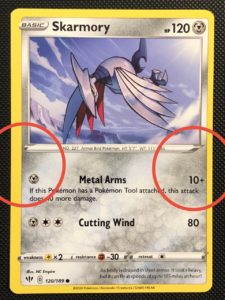
Why is the Quality So Bad?
The Pokémon Company (TPC) has not released a statement regarding the poor card quality as of late, however, it is not difficult to analyze the market and see that it is a simple supply and demand issue.
Pokémon cards vary in popularity year by year, but the launch of Pokémon GO in 2016 increased the demand. Luckily, TPC did not have any trouble keeping up with the new demand. However, a series of events (Logan Paul, pandemic lockdowns, global supply chain issues) in 2020-2022 sky-rocketed the popularity of the hobby. Demand was at an all-time high, and TPC could no longer meet the demand.
At this time, TPC did post on Twitter stating that they had ramped up production to an all-time high in order to help get products on store shelves.
This is when we saw the huge dip in quality. So the answer to the question is that the poor quality is due to high demand and the inability of TPC to satisfy that demand.
Why are Japanese Pokémon Cards Better Quality?
Japanese Pokémon cards have always been of better quality. Even today, they have a certain feeling of precision when holding one. Part of the reason that Vintage Japanese cards are often cheaper than their English counterparts is due to quality. Japanese cards are harder to damage, therefore, fewer of them have been destroyed over time.
This is probably due to the North American printing factories having to satisfy multiple markets across the globe, while Japanese factories only have to satisfy the Japanese market.
Final thoughts
It’s unfortunate that quality is currently suffering at the hands of the people who love to collect cards. One day, quality will certainly return to normal. In the meantime, we should keep a positive outlook and even be excited to pull outrageous mistakes from the factory.

Hi, I'm Oliver. I've been collecting Pokémon cards for 25+ years. I hope you enjoyed your read and learned something. Learn more about me on the About page.
